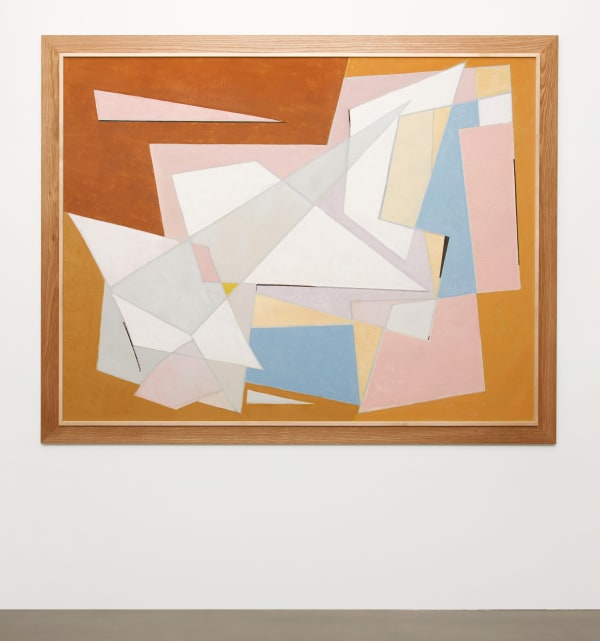GUÐMUNDA ANDRÉSDÓTTIR, ÞORVALDUR SKÚLASON, NÍNA TRYGGVADÓTTIR
Nína Tryggvadóttir (1913 – 1968)
Guðmunda Andrésdóttir (1922 – 2002)
Þorvaldur Skúlason (1906 – 1984)
i8 Gallery is pleased to announce an exhibition of three masters of Icelandic abstract painting: Nína Tryggvadóttir, Guðmunda Andrésdóttir, and Þorvaldur Skúlason. The exhibition offers an opportunity to reflect on the artistic relevance of a pivotal period in European art, the transition from early modernist ideals of the century’s first decades, to the emergence of the post-war avant-garde. While elsewhere in the sixties, abstract art was already being overshadowed by pop art, nouveau realisme, and minimalism, the pioneers of abstract painting in Iceland were at the peak of their careers and producing their finest work. Looking back, we now have a better perspective on the distinct artistic quality of these works and their enduring legacy. These three painters represent many of the best aspects of painting in the post-war period, each of them developing a distinctive character setting them apart from more familiar abstract movements in Europe and America.
Nína Tryggvadóttir, like many Icelandic artists in the first half of the twentieth century, began her studies in Copenhagen during the mid-thirties before moving to Paris. Her stay in Paris was cut short by the outbreak of the war and she escaped back to Iceland. At the height of the war, she received a grant to travel to New York where she came in contact with Fernand Léger and the German expatriate artist Hans Hofmann. Later, in the toxic atmosphere of the McCarthy years, she and her husband Dr. Alfred L. Copley, also known by his artistic alias Alcopley, were forced to resettle in Paris and London. In 1958, they returned to New York and in the years that followed, Tryggvadóttir created many of her most potent and mature works. Tryggvadóttir’s work has strong roots in Icelandic nature, specifically its energy and rough texture, but in the early sixties she spent time in Los Angeles where the desert landscape surrounding the city inspired a series of paintings where a dynamic composition and earthy colour palette were knit together by forceful brushwork and broad strokes of the painting knife. Her mature style combines elements of both the Parisian lyrical abstract painting and the American abstract expressionism of the post war period.
Guðmunda Andrésdóttir is the only artist of the three whose work has previously been shown at i8 Gallery, in 1998, four years before her death. Andrésdóttir studied in Stockholm immediately after the war, and for three years in Paris (1951 to 1953) where she developed the abstractionist style that became her hallmark. In Iceland, Andrésdóttir joined a group of painters called the Septem group and exhibited with them regularly. But being a reclusive and quiet person, she didn’t attract the same attention as many of her peers. In recent years, she has been rediscovered as a unique voice in a male dominated artistic milieu. Andrésdóttir’s art does not appear to be as inspired by natural themes as much of the abstract work in Iceland during the fifties and sixties. Her paintings are infused with a musical rhythm, combining pulsating energy and balanced repose. During the sixties, her art evolved into a style of repeated circles and lines suggesting a jazz-like improvisation, that plays with modulations of pictorial refrains based on structural and temporal dimensions.
Þorvaldur Skúlason was the oldest of the three artists and had already established his career in France during the thirties. At the outbreak of the war, Skúlason was living in Tours in western France, and narrowly escaped the invading forces, by ship from Bordeaux, leaving everything behind except the coat on his back. After settling in Iceland, he became the most vocal advocate of progressive artistic movements, and an intellectual beacon for the budding development of abstract art among Icelandic artists, which was met with vehement opposition from the wider public. He was instrumental in bringing together the Septem group which would become the main platform for abstract art in Iceland for three decades. Skúlason was constantly in search of new avenues to advance his style and in the early sixties his art entered a new phase inspired by the countryside of southern Iceland. The composition of these works consists of monochrome angular surfaces, intersecting and cutting into each other. Vibrant colour harmonies create an immersive atmosphere reminiscent of the blustery winds of early spring, the growing dusk of the sunset, or the turbulent waters of glacial rivers.
Gunnar J. Árnason









